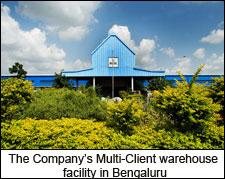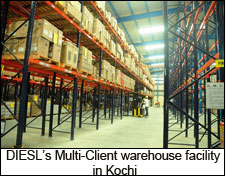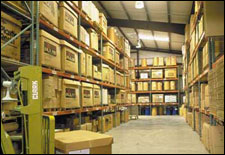DIESL (Drive India Enterprise Solutions Ltd), a Tata Group company and a leading provider of integrated logistics solutions to a wide range of industries, has over 165 warehouses connecting 7,000 towns across India. Milind Shahane, in an email interaction with Jibran Buchh, discusses threadbare the Indian logistics industry and the shape of things to come.
Can you share your outlook on the logistics sector?
Logistics plays a vital role in moving the end-product to the right audience, in the right quantities and at the right time. Services like transportation, warehousing, cross-docking, inventory management, packaging and freight forwarding all are part of third party logistic (3PL) services.
According to a report, companies in India currently outsource an estimated 52 per cent of their logistics requirement, with more and more organisations following these footsteps. The 3PL industry was estimated to be $1.5 billion in FY11. That 3PL represents only 1 per cent of logistics cost emphasises its growth prospective. Future, no doubt, lies in outsourcing. The growth is expected to be in the range of 25-30 per cent CAGR over FY11-13E.
As of now, the 3PLs mainly cater to industries like FMCG, FMCD, retail, automotive, IT hardware and telecom. Recent trends like emergence of organised retail, increase in foreign trade and India becoming soon the manufacturing hub may further propel the growth of logistics industry.
 What are the main reasons for higher logistics costs in India compared to China, Asia- Pacific, Europe and USA?
What are the main reasons for higher logistics costs in India compared to China, Asia- Pacific, Europe and USA?
There are major challenges in movement of goods and materials across various states in India. This is due to a variety of reasons like poor road, rail and other infrastructure, different taxes and regulations in each state, delays in checking at border crossings, the local taxes and checks like octroi, entry tax, various checkpoints of RTO and other agencies etc. These delay the movement of goods and also add to administrative costs both of which results in higher transportation costs.
The logistics companies also faces problems in movement of ODC cargo as there are many bottlenecks like electricity lines, weak bridges, narrow roads etc. These are the major areas where government needs to support the logistics sector for faster delivery of goods at lower costs.
But, higher logistics costs can make Indian businesses difficult to compete with their global counterparts.
A study conducted by FICCI states that the logistics cost of developed countries like USA and Japan is 9 per cent and 11 per cent respectively. Whereas, logistics cost as a percentage of GDP for developing nations like China is 17 per cent and India is 14 per cent. The reason for high logistics cost in developing countries like India are many, such as, inadequate road network coverage with multiple checkpoints, long and uncertain transit times, highly fragmented trucking industry, high rail freight tariffs and unavailability of special wagons for carrying specialised products.
The ICD/CFS infrastructure available for EXIM trade is also inadequate. With emerging requirements of integrated logistics, provision of transportation hub and value additions need large logistics parks which are yet to be developed. And last but not the least, fuel price hikes have sharply increased the cost of freight transport.
However, FDI in India has opened new opportunities for domestic logistics players since the multinational companies have huge demand of outsourcing their supply chain function as per international standards. Due to this sourcing is showing an uptrend and 3PL players have started implementing advance levels of technology like track & trace, warehouse & transportation management system to deliver timely information to their customer.
Material that is picked up and delivered on time without error reduces cost and satisfies customers. Hence, if we have to consider the current market scenario then yes, we have high logistics costs but at the same time logistics companies have the bandwidth and expertise to serve to its local and multinational customers which helps to compete globally.
 How can the government help reduce logistics costs in India?
How can the government help reduce logistics costs in India?
The government can play a major role in supporting the logistics sector by giving focus on development of infrastructure like roads, railways, ports, airports, logistics parks, warehousing and inland container depots. These would help to improve the storage and handling of goods and materials by providing facilities to logistics companies at reasonable costs.
Further, the government needs to also focus on reducing the administrative hurdles the industry is facing. Some of these are multiple checkpoints, delay in custom clearance and inspection, large amount of paperwork and bureaucratic procedures, requirement of road permit, way bills and forms for transit, compliance to variety of regulations etc. The procedures need to be simplified so that there will be a reduction in time and cost. These would help logistics companies to improve efficiency and productivity of the operations and reduce costs of handling and transportation.
How can better infrastructure improve reliability and reduce overall costs?
Visibility and reliability in supply chain go hand in hand. Infrastructure of the any nation acts as a backbone for its logistics industry because on-time distribution and last-mile delivery needs good connectivity of roads, rail, airports etc. End-to-end logistics cost, service level agreements, arranging warehouses at proper location (within city limits) and transportation parameters are always derived on the condition of the infrastructure in which LSP has to run the operations.
In addition to this, regulations on local permits, octroi and payment of multiple state and central taxes results in considerable loss of time in transit for road freight and adds up to the logistics cost.
On a positive note, however, good investments have been put in place for some major infrastructure projects like the Delhi-Mumbai Freight Corridor, new railway set-up, and better road networks and airports, which will enhance the infrastructure in the coming years. And once we have better infrastructure in place, it will automatically have a positive impact on Indian logistics operations and its service level agreements.
 Can you tell us about the key services DIESL provides?
Can you tell us about the key services DIESL provides?
DIESL is one of the very few organised logistics service providers in India, and the only 3PL from the Tata stable. DIESL has carved a niche for itself in this industry by providing end-to-end logistics services to more than 100 recognised brands, both in the Tata Group and outside, pan- India. We provide supply chain solutions to many sectors with a focus on FMCD, FMCG, telecom, hi-tech, chemicals and automobiles. Our 3PL services include warehousing, primary and secondary distribution, international logistics, trading, consignment sales, in-plant logistics, project logistics and value added services like kitting, packaging, cash management, last-mile deliveries etc.
Our comprehensive bouquet of offerings, coupled with extensive experience over the last 10 years, backed by internationally benchmarked IT systems (SAP, CRM, Warehouse Management System, Distribution Management System) have helped establish DIESL as a leading name in Indian logistics industry.
As the CEO of DIESL what milestones would you like your company to achieve?
DIESL is currently focused on sectors like FMCD, FMCG, telecom, retail etc. And a wide range of services like warehousing, distribution, primary & secondary distribution, packaging, etc. Our focus is on expanding 3PL contract logistics services to more sectors and also look at more products like in-plant logistics. We are looking to double our revenue over the next five years and are planning strategies and service offerings to achieve this milestone.












